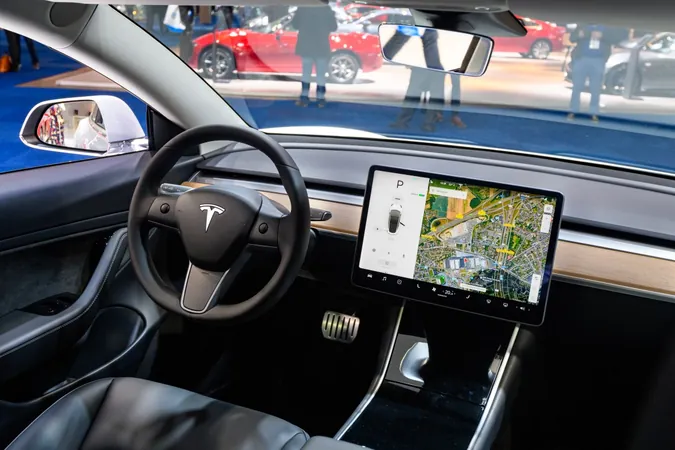
Tesla's Ambitious Robotaxi and Unsupervised FSD Plans Face Regulatory Hurdles
2024-10-15
Author: Lok
In the recent unveiling of its highly anticipated robotaxi, Tesla CEO Elon Musk announced plans to introduce an "unsupervised" version of the automaker's Full Self-Driving (FSD) technology by 2025 in Texas and California, specifically for certain Model 3 and Model Y vehicles. Musk also indicated that production of the steering wheel-free robotaxis would commence around 2026 or 2027. However, the feasibility of these timelines raises eyebrows as regulatory challenges loom large.
Understanding 'Unsupervised FSD'
While FSD stands for "Full Self-Driving," it’s important to clarify that the technology has not yet achieved true autonomy. Although it can handle some driving tasks competently in specific conditions, the system still requires driver attention. In response to past criticisms regarding its marketing, Tesla recently rebranded FSD from “FSD Beta” to “FSD Supervised,” highlighting the necessity of human oversight.
The term "unsupervised FSD" could imply two scenarios: a fully driverless Level 4 system, which operates autonomously within defined parameters, or a Level 3 system that allows limited hands-off driving but necessitates human intervention at times, similar to what competitors like Mercedes with its Drive Pilot are developing.
The Regulatory Maze Awaiting Tesla
Musk's plan to launch unsupervised FSD in California and Texas is multifaceted. Musk did not specify if this will come as an over-the-air software update or require additional payments from customers. In Texas, the pathway appears relatively clear, as the state’s laws permit the use of autonomous vehicles with minimal oversight, provided they comply with fundamental traffic laws and have appropriate insurance.
However, forthcoming legislative sessions in Texas may prompt stricter regulations requiring notifications to the Department of Motor Vehicles (DMV) when human drivers disengage—potentially complicating Tesla's rollout.
California presents a more intricate regulatory web. Tesla, along with over 30 other companies, holds a permit for drivered testing of its autonomous technology. Notably, Tesla has not pursued a driverless testing or deployment permit, essential for operating vehicles without a human in the driver’s seat. Any expansion of their testing fleet would necessitate relevant updates and applications to the California DMV.
If "unsupervised FSD" involves a Level 3 system rollout, Tesla would require a simpler deployment permit. However, a Level 4 system—currently highly sophisticated—would mandate both driverless testing and deployment permits, alongside complex regulatory assessments for passenger transport.
Potential Federal Compliance Challenges
Musk’s robotaxi concept promises autonomy, but the absence of steering wheels or pedals invites compliance issues with federal safety standards (FMVSS). For large-scale production of such vehicles, Tesla would likely need an exemption, a process that has not been initiated according to the National Highway Traffic Safety Administration (NHTSA).
Historically, obtaining these exemptions has proven challenging—even General Motors faced obstacles with its Cruise Origin vehicles. While the NHTSA anticipated announcing new regulations accommodating vehicles without human controls, delays have left the regulatory landscape uncertain.
Financial Impacts and Investor Concerns
The combination of ambitious technological goals, murky regulatory frameworks, and Musk's lack of clear communication regarding the compliance strategies for these innovations has unsettled investors. Following the announcement event, Tesla’s stock fell nearly 10%, reflecting growing skepticism over the feasibility of the timelines established by Musk.
In summary, while Tesla's futuristic vision of robotaxis and unsupervised FSD technology captivates audiences, significant regulatory, operational, and compliance challenges must be navigated before these vehicles hit the road.
 Brasil (PT)
Brasil (PT)
 Canada (EN)
Canada (EN)
 Chile (ES)
Chile (ES)
 España (ES)
España (ES)
 France (FR)
France (FR)
 Hong Kong (EN)
Hong Kong (EN)
 Italia (IT)
Italia (IT)
 日本 (JA)
日本 (JA)
 Magyarország (HU)
Magyarország (HU)
 Norge (NO)
Norge (NO)
 Polska (PL)
Polska (PL)
 Schweiz (DE)
Schweiz (DE)
 Singapore (EN)
Singapore (EN)
 Sverige (SV)
Sverige (SV)
 Suomi (FI)
Suomi (FI)
 Türkiye (TR)
Türkiye (TR)